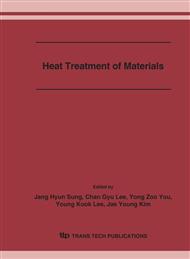p.609
p.615
p.623
p.635
p.639
p.645
p.651
p.655
p.661
Production of Cu-Hf-Ti Bulk Glassy Composites by Mechanical Alloying and Spark-Plasma Sintering
Abstract:
This work reports on the production of Cu-Hf-Ti bulk glassy composites through a powder metallurgical route, i.e. by mechanical alloying and subsequent spark-plasma sintering. Powders of Cu60Hf30Cu10 and Cu60Hf25Ti15 composition were prepared using a high-energy planetary ball-mill. Both alloys nearly showed a fully amorphous structure with only a small fraction of residual HCP Hf grains left after 50 h of milling. Differential scanning calorimetry (DSC) analyses of the milled glassy powder revealed a two-stage crystallization process for both compositions. However, the released crystallization enthalpy was substantially larger for the Cu60Hf25Ti15 alloy than for the Cu60Hf30Ti10 alloy, suggesting that the former comprises a higher fraction of the amorphous phase than the latter. Both powders showed distinct glass-transition with a large super-cooled liquid region. Consolidation of Cu60Hf25Ti15 powder was carried out by means of spark-plasma sintering at applied pressures of 200 and 500 MPa, choosing a sintering temperature within the super-cooled liquid region (T = 753 K). The sintered compacts exhibited some pores and interparticle boundaries.
Info:
Periodical:
Pages:
655-660
Citation:
Online since:
December 2006
Authors:
Price:
Сopyright:
© 2006 Trans Tech Publications Ltd. All Rights Reserved
Share:
Citation:


